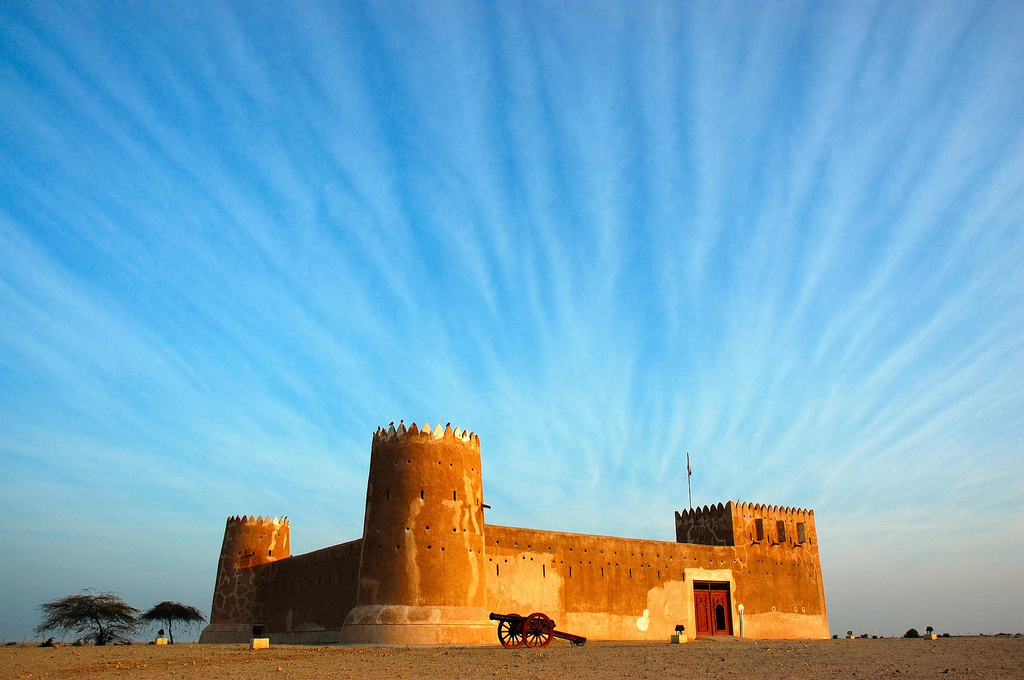Al Zubarah, Qatar’s Model for Social, Economic Transformation
موقع الزبارة نموذج للتحول الاجتماعي والاقتصادي في قطر
QNA
Doha: Al Zubarah, the State of Qatar’s largest heritage site, remains a witness to the history and heritage of the Qatari people. It is an authentic Qatari landmark and a unique model for the social and economic transformation in the country. There, the pearl trade flourished, making the place a cultural hub that embraced many literary figures who expressed the authentic Qatari sentiment and human interaction between the sea and the desert.
Due to the importance of this heritage site and its place in the conscience of the Qatari people, the efforts to include it in the UNESCO World Heritage Sites list were successful on June 22, 2013. UNESCO’s decision was supported by the universal value of Al Zubarah site and its connection to human development and the growth of society in Qatari history.
At the height of its prosperity, the heritage site was a trade bridge between the Indian Ocean, the Arabian Peninsula, and Western Asia. The coastal and walled city of Al Zubarah flourished in the northwest of the State of Qatar as an important commercial center between the 18th and 19th centuries. Al Zubarah includes an amazing city wall, residential palaces, homes, markets, industrial areas, and mosques.
The first to classify Al Zubarah as a heritage site was a team of Danish archaeologists in the fifties. Afterward, a team of Qatari and Danish archaeologists carried out excavations at the site. After conducting studies and research on the site, a large group of archaeological items dating back to the 18th and 19th centuries were found. Those items are displayed in the galleries of Al Zubarah City Museum.
Al Zubarah is distinguished because it presents prominent evidence of the active trade and pearl diving that preserved the main coast of the region from the early Islamic period until the early 20th century. It is also an embodiment of a series of cultural and architectural institutions in the region.
This heritage site remains a witness to human interaction between the sea and desert environment in northern Qatar and the region. The weights used by pearl divers, ceramics, sailboats, fisheries, wells, and agricultural activity appear at the site. The site is also a witness to how the city of Al Zubarah was a major center driven by trade, which made it a historical site that indicates that the people of the town engaged in various business activites since ancient times.
The city of Al Zubarah is the largest heritage site in the State of Qatar and the Arabian Gulf between the 18th and 19th centuries. The site is distinguished by its wall, residential buildings, and markets. It includes three major features, the largest of which are the archaeological remains of the town, dating back to the 1760s, the settlement of Qal’at Murair, which goes back to the Abbasid period due to the way fortifications were built, and Al Zubarah Fort built in 1938.
The archaeological and cultural site of Al Zubarah represents a unique model of social and economic transformation because it was a thriving port for the pearl trade and a cultural hub through the literary figures that emerged in the city.
FIFA World Cup Qatar 2022 visitors will be able to visit the showroom at Al Zubarah heritage site to discover more about the Fort’s history, its surrounding environment, and ongoing projects for its maintenance and restoration.
Al Zubarah Fort was built by Sheikh Abdullah bin Jassim Al-Thani in 1938 to guard and protect the northwest coast of Qatar.
Al Zubarah Fort is currently managed by Qatar Museums. It has been renovated and converted into a museum to display various artworks, especially for contemporary topical archaeological findings.
Al Zubarah Fort is located in the ancient city of Al Zubarah on the northwest coast of the Qatar Peninsula in the Al Shamal Municipality, about 105 kilometers from Doha, the capital of the State of Qatar. With an area of 60 hectares, Al Zubarah is the largest heritage site in the Arabian Peninsula.
قنا
الدوحة: يظل موقع الزبارة، أكبر موقع أثري بدولة قطر، شاهدا على تاريخ وعراقة القطريين، حيث إنه معلم قطري أصيل، ونموذج فريد للتحول الاجتماعي والاقتصادي في البلاد، فمنه ازدهرت تجارة اللؤلؤ، كما كان مركزا ثقافيا احتضن الكثير من الشخصيات الأدبية التي برزت في مدينة الزبارة، وعبرت عن الوجدان القطري الأصيل والتفاعل الإنساني بين البحر والصحراء.
ولأهمية هذا المعلم الأثري واستحضاره في وجدان الشعب القطري، تكللت مساعي انضمامه إلى قائمة منظمة /اليونسكو/ الدولية لمواقع التراث العالمية، بالنجاح في 22 يونيو من عام 2013، حيث كان القرار الدولي مدعوما بالقيمة العالمية لموقع الزبارة، وارتباطها بتنمية الإنسان ونمو المجتمع في جانب من التاريخ القطري.
كما كان المعلم الأثري في ذروة ازدهاره، جسرا تجاريا بين المحيط الهندي وشبه الجزيرة العربية وغرب آسيا، حيث ازدهرت مدينة الزبارة الساحلية والمحاطة بأسوار في شمال غرب دولة قطر، كمركز تجاري مهم ما بين القرنين الثامن عشر والتاسع عشر، وتضم الزبارة سور المدينة المذهل، وقصورها السكنية، وبيوتها، وأسواقها، ومناطقها الصناعية، ومساجدها.
وصنف فريق من علماء الآثار الدنماركيين مدينة الزبارة كموقع أثري للمرة الأولى في الخمسينيات من القرن الماضي، ليقوم بعدها فريق من علماء الآثار القطريين والدنماركيين بأعمال التنقيب في الموقع، وعقب إجراء دراسات وأبحاث على الموقع، تم العثور على مجموعة كبيرة من المكتشفات الأثرية التي تعود إلى الفترة الممتدة ما بين القرن الثامن عشر والقرن التاسع عشر، ويتم عرضها في صالات عرض متحف مدينة الزبارة.
وتتميز الزبارة بتقديم شواهد بارزة على التجارة النشطة والغوص بحثا عن اللؤلؤ الذي حافظ على الساحل الرئيسي للمنطقة من الفترة الإسلامية المبكرة وفي وقت سابق للقرن العشرين، كما أنها تجسيد لسلسلة المؤسسات الحضارية والمعمارية في هذه المنطقة.
ويظل هذا الموقع الأثري شاهدا على التفاعل البشري مع البحر والبيئة الصحراوية في شمال قطر وفي المنطقة، حيث يظهر هناك أوزان غواصي اللؤلؤ، والخزف، والمراكب الشراعية، ومصائد الأسماك، والآبار، والنشاط الزراعي، وكيف كانت مدينة الزبارة مركزا رئيسيا مدفوعة بالتجارة، ما جعلها موقعا تاريخيا يدل على اشتغال أهل المدينة منذ القدم بالأعمال التجارية المختلفة، ومدى ارتباطهم الوثيق بالبحر والبر، ويقدم نموذجا لتأسيس التنمية وبناء الحياة بربطها مع الثقافات الأخرى من خلال التجارة.
وتعد مدينة الزبارة أكبر موقع أثري بدولة قطر والخليج العربي في الفترة ما بين القرنين الثامن عشر والتاسع عشر، حيث يمتاز الموقع بسوره والمباني السكنية والأسواق، ويتألف موقعها من ثلاثة أجزاء رئيسية وهي، موقع مدينة الزبارة الأثري الذي يعود تاريخه إلى 1760، وقلعة مرير التي ترجعها المكتشفات والدراسات الأثرية إلى الفترة العباسية بسبب طريقة بناء التحصينات لهذه القلعة، وقلعة الزبارة التي شيدت عام 1938.
يمثل موقع الزبارة الأثري والثقافي نموذجا فريدا للتحول الاجتماعي والاقتصادي لأنه يعتبر ميناء مزدهرا لتجارة اللؤلؤ، كما كان مركزا ثقافيا، وهو ما نجده من خلال الشخصيات الأدبية التي برزت في مدينة الزبارة.
وسيكون بإمكان زوار بطولة كأس العالم FIFA قطر 2022، زيارة صالة العرض في موقع الزبارة الأثري لاكتشاف المزيد عن تاريخ القلعة، والبيئة المحيطة بها، والمشاريع المستمرة لصيانتها وترميمها.
وقد بنى الشيخ عبدالله بن جاسم آل ثاني قلعة الزبارة في عام 1938 بهدف حراسة وحماية ساحل قطر الشمالي الغربي، وكانت إحدى القلاع الساحلية التي ضمتها المنظومة الدفاعية للبلاد، علاوة على استخدامها كمركز لسلاح الحدود حتى شهر يونيو من العام 1986.
وتدير هيئة متاحف قطر حاليا قلعة الزبارة، حيث تم تجديدها وتحويلها إلى متحف لعرض الأعمال الفنية المتنوعة وخاصة بالنسبة للنتائج الأثرية الموضعية المعاصرة.
وتقع قلعة الزبارة في مدينة الزبارة العتيقة عند الساحل الشمالي الغربي لشبه جزيرة قطر في بلدية الشمال وتبعد حوالي 105 كيلومترات عن الدوحة عاصمة دولة قطر، وهي مدينة تاريخية غير مسكونة حاليا، وتبلغ مساحة الزبارة حوالي 400 هكتار، وذلك إلى جانب ما يحيطها من الأعمال الأثرية على مساحة 60 هكتارا، وبالتالي تعد الزبارة أكبر موقع أثري في شبه الجزيرة العربية بأكملها.




